
ELVA-1 Fully Autonomous Driving of a Shunting Locomotive with E-band Radar Control
This ELVA’ blog article focuses on the use of millimeter-wave radars on railroads. Rail applications for radars include speed and range sensors for unmanned self-driving locomotives (also operating within industrial sites), assistance for shunting operations at rail stations, and safety application intended for preventing dead-end train collisions at stations and depots.
Here you will find a general overview of the millimetre-wave railway radars and how they work in the railway infostructure. It will also explain why radar is more reliable in bad weather conditions than other types of speed and distance measuring devices such as laser sensor (rangefinder). More details on the use of mm-wave radar on railways will be given in additional posts.
Introduction to the Use of Millimeter-Wave Radar for Rail Applications
Radar is a fairly new technology for rail applications. However, the emergence of unmanned locomotives is a good incentive for more active implementation of radars on locomotives and passenger station dead-ends.
Millimeter wave band is designated as frequency spectrum between 30 to 300 GHz, which corresponds to the 10 to 1 mm wavelength. Despite having such a large chunk of the mm-wave spectrum, not all of it can be used for commercially viable and technically feasible rail applications. The reason is the different absorption of the signal in the atmosphere at different frequencies and the regulatory guidelines of the FCC and ETSI.
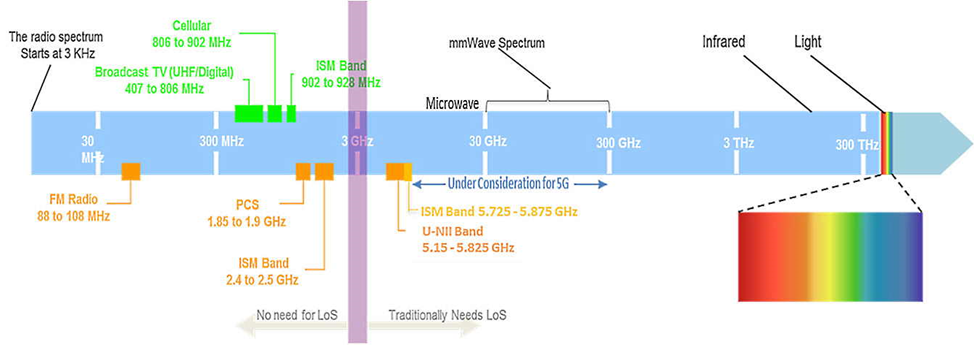
Regulators originally envisioned 76-81 GHz frequencies for automotive radars, but today they are talking about allowing low-power radars for any moving platform applications, i.e., for intelligent transport system applications.
Essentially, rail radarsensor is a kind of a digital eye that controls the movement of an autonomous driverless train or helps the locomotive driver to stop the train in the right place when moving backwards or just without clear visibility. In the case of backward movement when using radar, the locomotive driver can work without the help of a special employee – the coupler, who is at the other end of the train. This saves budgets and boosts productivity
What Is Millimeter-Wave Radar for Rail Applications
Millimeter wave radar is a type of sensor technology that uses high frequency radio waves to detect obstacles (often called as targets) and measure their distance from the loco and approach speed. Radars are more commonly used on driverless locomotives for shunting operations and to help avoid collisions.

Here’s how millimeter wave radar works:
- The radar emits a high-frequency radio wave signal (e.g., at 76 GHz) in the moving direction of the locomotive.
- The radio wave signal travels through the air and reflects off any objects in its path, such as other locomotive, railcar, or any obstacle on the track.
- The reflected radio wave signal is detected by the radar, which then passes to onboard computer unit to calculate the distance from the loco to obstacle. This calculation is based on the time needed the signal to bounce back.
- The autonomous locomotive’s computer system uses this information independently or transmits data to the traffic control center to make braking decisions to avoid collisions and safely navigate within the track.
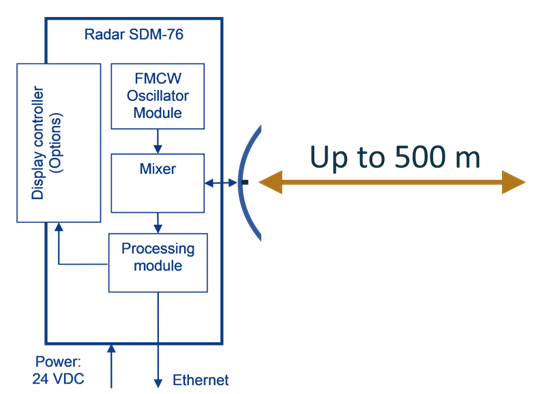
Although the radar is an analog device, modern radars have a digital output based on Ethernet, allowing to process the signal in onboard or remote computer to safely operate the locomotive, either with a driver or unmanned.
Millimeter-Wave Radar Advantages for Rail Applications
The advantages of millimeter wave radar sensors include their ability to operate in harsh weather conditions, its high accuracy and a long range.
Note. You may ask — why the term millimeter-wave “radar sensor” is used and how it differs from just a radar. It’s simple, radar is a fully functional device with its own screen for human personnel to assess the situation in the monitored area. The radar sensor just transmits a digital signal to the locomotive computer unit or remote server, and there it is algorithmically processed to decide whether the obstacles are dangerous and whether it is necessary to brake.
All-weather 76 GHz rail radar sensors are designed to operate in harsh weather conditions, including rain, fog, dust, smoke, snow, and direct sun exposure which can significantly impair the performance of laser sensors. This is because laser sensors emit a beam of light that can be scattered or absorbed by particles in the air, such as raindrops or snowflakes. In these conditions, laser sensors can produce erroneous data, including false readings or “direct sun to eye” errors, which occur when the sun’s rays interfere with the laser sensor’s optics, causing the sensor to malfunction.
Radar sensors with 76 GHz, on the other hand, use radio waves that are less affected by environmental factors such as precipitation or poor visibility. Radar sensors can detect objects and measure their distance, speed and direction by emitting radio waves and analyzing the reflected signals. This means that 76 GHz radar sensors are less prone to distance and speed errors than laser sensors, making them more reliable for use in railroad applications.
Additionally, 76 GHz radar sensors have a longer range and wider field of view than laser sensors, allowing them to detect and track objects at greater distances and across a broader area. This can be especially important in autonomous vehicle applications, where the ability to accurately detect and track objects is critical to ensuring safe and reliable operation.
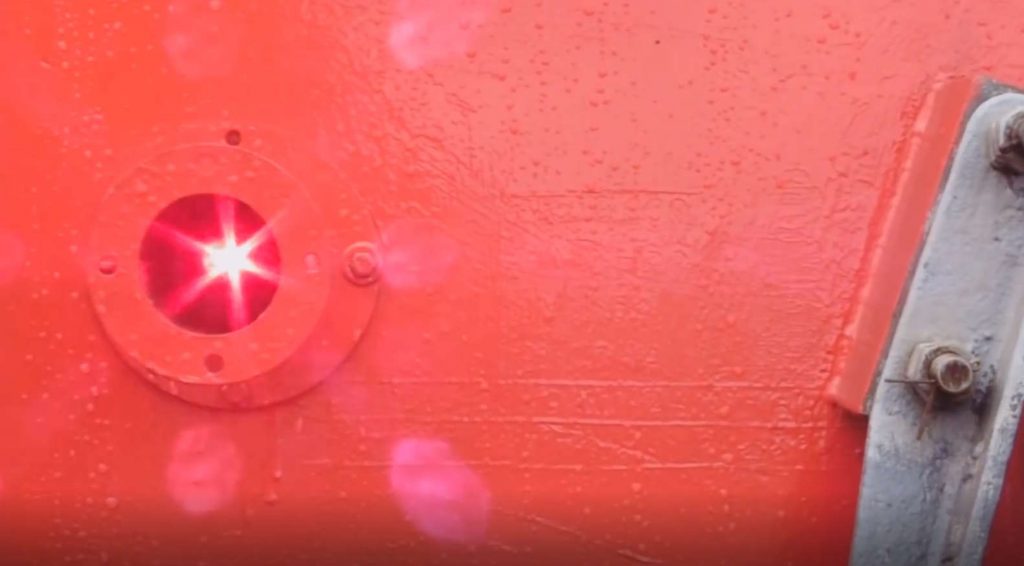
The frontal video camera on an unmanned locomotive also cannot replace radar, as it does not work in fog, dust or smoke conditions. In general, the video camera can serve as a complement to the radar, so that the dispatcher can see the real-time situation as from the cab of the locomotive
ELVA-1 Millimeter-Wave Radar Sensor for Shunting Rail Application
Let’s take a look at the photo of ELVA-1 millimeter-wave radar sensor, which is used in rail transport. In addition to the sealed housing, because it has to work under rain, snow and dust, you see an antenna 60 cm in diameter.
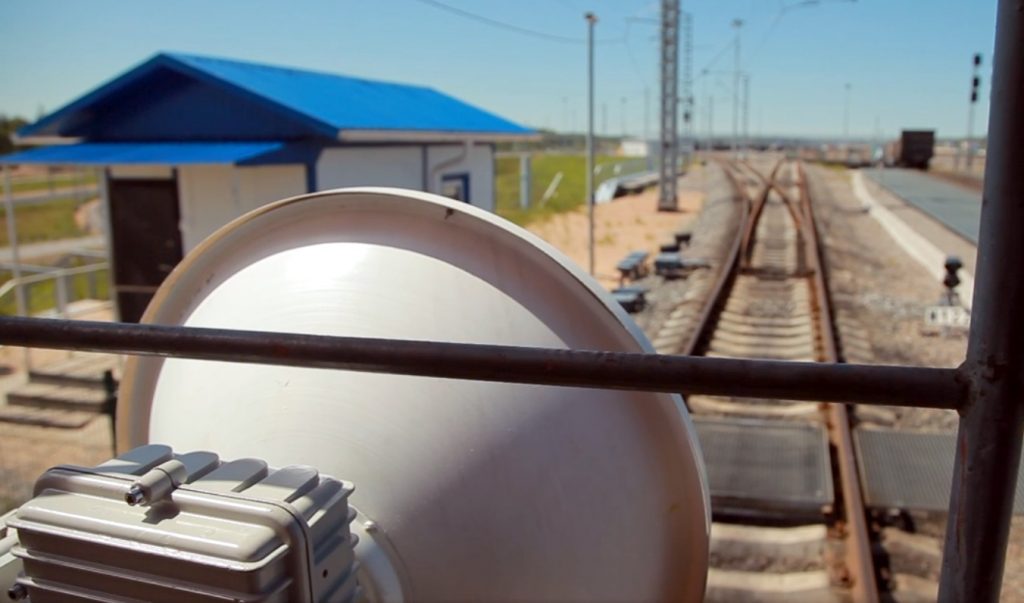
The size of the antenna is determined on the distance range at which the radar is able to detect obstacles within the designated area. The fact is the radar beam has to go strictly along the track. This is to avoid reflections from false targets such as contact wire poles, trains on neighboring tracks, etc. The overall track width, including the space between the rails and additional components such as ballast and ties, can vary depending on the design and construction of the railway system, but usually is about 4 m.
For example, in the U.S., the overall track width can be from approximately 9 to 14 feet (2.7 to 4.3 meters), depending on the type of track and the specific requirements of the railroad company. In Europe, the overall track width can range from approximately 11 to 16 feet (3.4 to 4.9 meters), again depending on the specific requirements of the railway system.
The larger the antenna, the narrower the radiation pattern is, or in other words, the thinner the beam it radiates. For example, an antenna with a diameter of 60 cm has a beam width of half a degree. This allows you to see the track ahead for about 500 m without reflections from sideline false targets. At the far point at a distance of 500 m the beam width from the antenna does not exceed 4.3 m, without affecting the neighboring tracks.
A smaller antenna, e.g., 30 cm or even 20 cm in diameter, could be also used with ELVA-1 rail radar, but then the beam would be wider and the effective radar range would be reduced. This is to ensure that the width of the beam does not exceed the total width of the track (about 4 m).
Active radar responder allows to improve post-processing of the signal due to the signal quality stands out significantly against the background of reflections from surrounding objects (other locos, railcars, buildings, poles, fences, etc.).
The accuracy of the radar distance for the typical ELVA rail radar is 15 cm, and the speed is measured with an accuracy of 1 km/h. This is sufficient for maneuvering an unmanned locomotive in the station or depot.
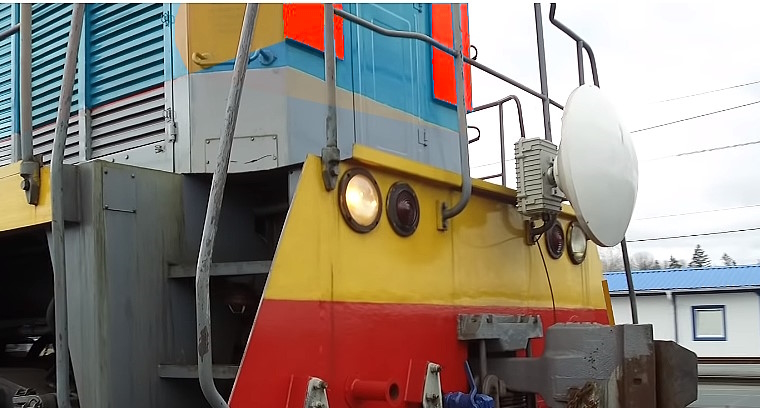
ELVA-1 Precision Mm-Wave Radar Sensor for Industrial Rail Systems
Controlling unmanned freight or specialty trains in industry apps requires a particularly high degree of accuracy in determining their speed, distance to obstacles, and exact stopping point. For example, an unmanned quenching car in the process of extinguishing wet coke must be positioned to the furnace doors with a high accuracy of 35 mm.

In order to achieve such a high accuracy of locomotive movement on the territory of the industrial site, an active radar responder can be installed on the locomotive. And the radar itself would be installed not on the locomotive, but on a fixed support in the alignment of the track. Then the signal will be received clearly from the loco’s responder, which to achieve a very high accuracy of locomotive positioning.
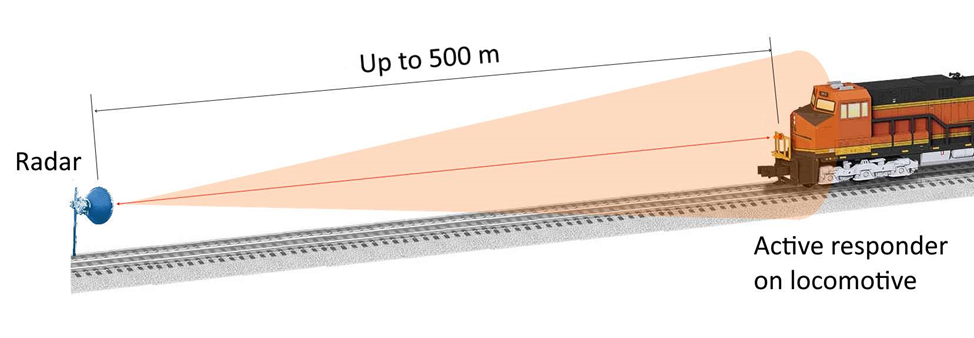

ELVA-1 Millimeter-Wave Radar Sensor for Safe Approaching a Dead End on a Railroad Track
Another one application of the mm-wave rail radar sensor in this post is monitoring the speed and distance of a high-speed passenger train arriving at a dead-end station track. This ELVA-1 rail radar has a digital output that transmits radar data to the traffic control center for an extra safety.

Note. You may ask — how important is radar’s range of about 500 m for pre-empting a train collision with an obstacle like track dead-end? The distance of 450 to 500 meters (1,476 to 1,640 feet) seen ahead by the rail radar would be sufficient for a typical passenger train traveling at 80 km/h (50mph) to come to a complete stop under normal operating conditions.
Using Rail Radar as a Sensor for Data Processing in Traffic Control Room
Any of rail radar application including unmanned loco shunting operation or speed and distance monitoring of train in a dead-end needs data processing in traffic control center to make decisions.
The task of rail radar sensor is only to transmit reliable digital data to the traffic control center. The server in this center continuously processes the speed and position of the locomotive or train in relation to the tracks and gives the command to continue of moving or brake.
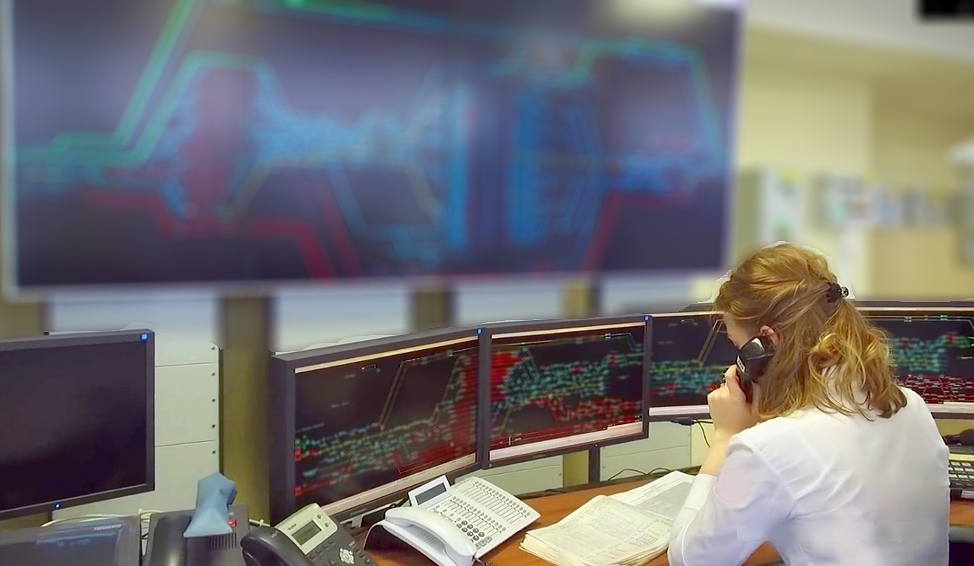
TTherefore, multifunctional software is installed on the control center server, which helps experienced dispatchers constantly monitor the operation of unmanned autonomous locomotives and trains.
76 GHz mm-Wave Radar Sensor with Phased Array Antenna for Obstacle Detection on Railroad Tracks
To solve the problem of safe maneuvering of the locomotive or train in the presence of railway curves, the presence of tunnels, etc., it is necessary to use a scanning system to determine the presence of foreign objects (obstacles) on the roadway and distinguish them from the safe infrastructure objects along the track. For this purposeб it is necessary to use a set of radar sensors synchronized in time.
Elva-1 offers a technical solution that allows scanning within a narrow beam along a single coordinate, the ordinate X axis. Our solution allows you to determine the angular position of the object by the phase difference of the incoming signal to two different mm-wave receivers on board the locomotive.
Although gauge sizes vary slightly from country to country (as we said above), we can determine the minimum distance for a train to safe pass, which is about 4,000 mm. The maximum width of the train contour is 3750 mm (from the central axis of the tracks). Thus, the minimum clearance is 125 mm on each side of the train.
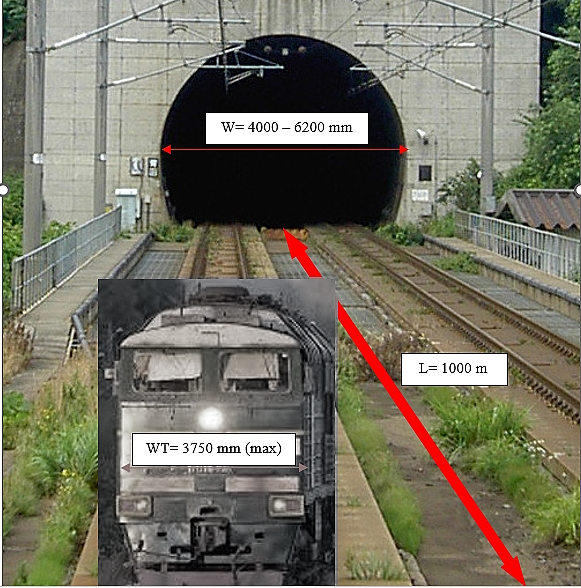
It is also important to consider the radar cross-section (RCS), also called radar signature. This is a measure of how detectable an object is by radar. A larger RCS indicates that an object is more easily detected. Small targets such as debris on the track, small animals, birds on the track will not be taken into account.
The system will allow to scan the railroad ahead in the required angular sector of 0.35 degrees with a resolution < 0.01 degrees in order to distinguish objects that are within the railroad track from objects outside it. A typical task is to find a passenger car or a cow on the railroad track, while distinguishing this target from the tunnel walls, which are only a min distance of 125 mm away from the train gauge.
For maximum radar range is 1000 meters and the RCS of the target = 1 square meter, a scanning radar system based on two receivers and two transmitters with an antenna diameter of 320 mm can be built to provide a scanning angle of 0.35 degrees.
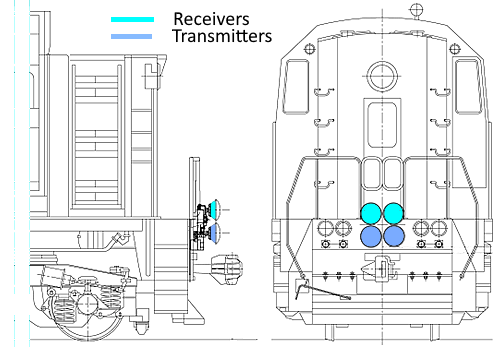
ELVA-1 mm-wave scanning radar system provides a working distance of 0.5 to 1000 m with high range resolution of 0.5 meters and high angular resolution equivalent to 12.5 cm at 1000 meters within the gauge of the railway track. The angular resolution allows detection of a minimum gap of 12.5 cm between the sides of the train and the tunnel wall. This detection will work at train speeds up to 200 km/h.
Summary
ELVA rail radar sensors are the ultimate rail safety tool, equipped to digital output and handle any environmental conditions. With its fast update rate, even high-speed trains can be safely monitored – giving operators plenty of time for a timely response. With our solutions available for testing and research on train operations, it’s never been easier or safer to upgrade your transport system to driverless autonomous operations.
